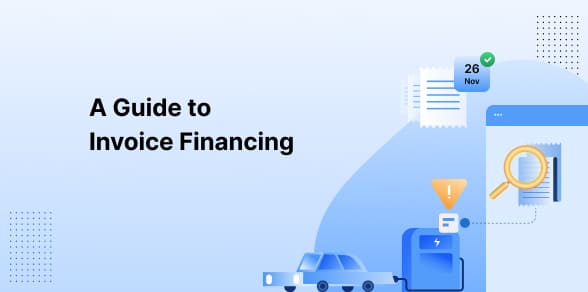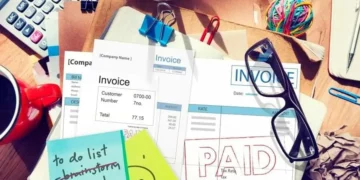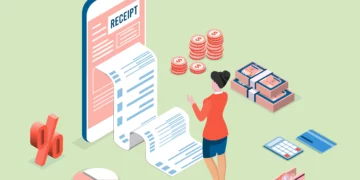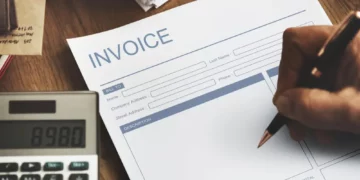Last Updated on November 28, 2025
Invoice financing
When was the last time you chased a client for your unpaid invoices? This week? Or the week that went by? Probably the previous month as well? Late payments for invoices are usual, and businesses can lose 15 days’ worth of productivity following up for late payments.
Furthermore, late invoices lead to delays in payment to suppliers and employees. Overcoming this situation is possible through Invoice Financing. But what exactly is it, and what are the benefits? Let’s explore that as we get started with understanding the concept first.
What is invoice financing?
Invoice financing, also called accounts receivable financing, allows business owners to get funds from third-party agencies for outstanding payments for their invoices. Borrowing money enables organizations to pay their suppliers and employees without delays.
Such service providers charge a small fee for the services offered. It is a win-win situation for everyone as businesses can continue their operations without losing focus.
Also, Read: What is E-invoicing?
Types and examples of invoice financing
Here is a detailed example of invoice financing to understand the concept better. Since it involves invoice factoring and invoice discounting, let’s look at both these examples.
1. Invoice factoring
Invoice factoring is a type of invoice financing where you sell your outstanding invoices to third-party agencies. You get cash money upfront in return for selling the invoices. Since there are no lending or loan characteristics involved, there is no impact on the credit lines of your business.
Example:
Let’s assume your company has an outstanding invoice of $10,000 from a customer with a due date is 60 days. Instead of waiting two months to receive the payment, you approach an invoice financing lender. The lender will check your customer’s creditworthiness to assess risk.
Once cleared, the invoice financing company will offer up to 85% of the amount, which comes to $8,500. The invoice financing company will collect the entire amount from your customer and pay you after deducting the fee for their services. The working capital you receive helps you pay your customers and employees timely.
Also, Read: Different Types of Invoices
2. Invoice discounting
Invoice discounting is almost similar to invoice factoring, where you get paid for your outstanding invoices from a third-party agency. The difference here is that the amount you receive is a percentage of the overall invoice value. Furthermore, the lending agency takes responsibility to collect the outstanding payment from your customer.
Example:
Let’s consider you have $80,000 worth of receivables from your clients in the next 30 days. However, it’s the month’s end and you need funds to pay your employees’ salaries immediately. You then approach the lender and ask for financing by showing your invoices.
The lender agrees to pay 80% of the amount, which is $64,000, with an interest of 5%. You use $64,000 to pay the salaries of your employees. When you receive outstanding payments from your customers, you pay back the lender the principal sum ($80,000) and 5% interest ($4,000). The lender receives $84,000 out of which $4,000 is their fees.
Also, Read: Purchase Order and Invoices
Differences between invoice factoring and invoice discounting
Here are the various differences between invoice financing and invoice discounting.
Invoice Factoring |
Invoice Discounting | |
| Other names | Invoice discounting, accounts receivable financing. | Accounts receivable factoring, factoring. |
| Structure | The outstanding receivables act as a line of credit. | Factoring company purchases the outstanding invoice at discounted rates and offers upfront payment. |
| Payment collections | You are responsible for collecting outstanding payments from your customers. | The factoring company remains responsible for collecting outstanding payments. |
How does invoice financing work?
When you sell goods or services on credit, you send an invoice to the customer with purchase details and the payment terms included. The customer then has a set period to pay the invoiced amount.
Invoices, however, do not always get paid on time. Almost 54% of SMEs in a survey accepted they would get paid late for their invoices. Invoice financing comes across as a savior for business owners as you get paid immediately for your invoices.
Here’s how the invoice financing process works:
- Company X raises the invoice for the goods or services delivered to their customer.
- X then sends the invoice details to the invoice financing lender.
- The lender issues up to 80-85% of the invoice value after evaluating the credentials of X.
- X gets paid from the customer for the invoice.
- X then repays the owed amount to the lender, along with service fees.
Quick Read: Invoice Management: Types, Process, Systems
Things to consider for invoice financing
Invoice financing works like any other financial product making it vital to assess this option thoroughly before proceeding.
Let’s look at the considerations to keep in mind when opting for the invoice financing option.
1. Customer types
Lenders offer financing services only for commercial invoices. It means your customers need to be a valid business entity. You cannot get invoice financing facility when dealing with the regular public as your customers.
2. Customer relationships
Invoice factoring, which involves selling some or all the invoices to a third party, can potentially damage your relationship with your clients. Payment issues can be sensitive and need careful handling by the third-party company. The upside is you do not have to chase your clients for payments for outstanding invoices.
3. Costs
Invoice financing is an excellent solution for the short term when you need a cash advance for your business. However, when you consider the long term, business owners can lose hundreds and thousands of dollars each year behind interest rates and processing fees.
Read More: 5 Ways to Simplify Your Invoice Processing
Pros and cons of invoice financing
Here are the various pros and cons of invoice financing to help you decide better.
Advantages:
1. Immediate funding
The process is quick, and you can complete it within two weeks. Furthermore, the financing happens immediately once all the formalities get completed.
2. Improved cash flow
Businesses can expect improved cash flow as funds do not remain stuck due to late payments. The health of the business thus remains unaffected.
3. No collaterals
Unlike regular business loans, there’s no collateral requirement for invoice financing. Invoices themselves are the only security for the lender. It is ideal for small businesses that would usually not qualify for business loans.
4. Flexibility
It allows different types of businesses to sell their invoices whenever they feel like it. There are no compulsive terms and obligations to follow.
Also, Read: Difference between Invoice and Bill
Disadvantages:
1. Costs
Lenders charge processing costs and interest that can quickly add up. Though financing gives you easy access to cash, the related costs will affect your profit margins.
2. Business relationships
Your relationships with your customers may get affected if the financing arrangement does not go well. A lack of payment flexibility for your customers can be the prime reason.
How to qualify for invoice financing?
It is more seamless to get qualified for invoice financing than seek a business loan. The minimum eligibility criterion is to own a business-to-business model for your company and have outstanding client payments.
Besides the fundamental criteria, individual invoice financing lenders may have their qualification norms. One of the essential ones includes the repayment history of your clients. They may also consider other usual loan requirements like annual revenues and credit worthiness. If your business has been around for a while with positive credentials, you can expect to receive financing in no time.
Also, Read: How to Avoid Invoice Discrepancy?
How to apply for invoice financing?
Knowing the finer details of the application process is crucial once you qualify for invoice financing. The process is basic and completes much faster than other business loans. Invoices are the only essential document you need. However, a lender may also ask for other details for KYC purposes.
Some of the other vital documents include:
- Financial statements
- Bank statements
- Credit scores
- Cancelled business cheques
- Identity proof
Also, Read: 12 Best Invoicing Software
How much does invoice financing cost?
Invoice financing cost includes the service fees and interest rates (if any) charged by the lender. It can usually be between 1 and 3%, which is a fixed sum irrespective of the repayment duration. For example, if the lender lends $10,000, the service fees for invoice financing at 2% will be $200.
Invoice financing in India
Invoice financing in India is a growing trend as businesses find it a better alternative to seeking traditional loans. It is especially true for small Indian businesses that may not meet the eligibility criteria for loans.
Such companies expect to get short-term liquidity even during a financial crunch and ensure their customers and employees receive their payments timely.
Automation options in invoice financing
With invoice financing being a complex process, automation assumes immense importance to ensure things remain on track. The traditional and manual processes can become overwhelming when the volume of clients and their invoices increases.
Automation helps overcome this challenge by eliminating labor-intensive and error-prone tasks. The process ultimately becomes transparent and risk-free.
Read More: A Complete Guide to Invoice Automation
In a nutshell
Invoice financing is an excellent option for small businesses and start-ups looking for immediate funds to continue their operations. The entry barrier is the least as the company needs to have a business-to-business model and outstanding client receivables. By paying service fees, businesses ensure their suppliers and employees get their payments and salaries timely.
Schedule a Demo for Invoice Management Software
FAQs:
1. Is invoice financing risky?
The only major risk with invoice financing is that businesses can start relying on it heavily. Furthermore, consistent late payments from clients can lead to higher processing costs.
2. What is an invoice financing platform?
An invoice financing platform is a lender that provides related services. Such service providers offer funds for about 80-85% of the invoice value in exchange for a service fee.
3. What is the difference between invoice financing and factoring?
Invoice factoring is one of the types of invoice financing where you can borrow and get business finance against outstanding invoices.
4. What is the difference between invoice financing and discounting?
Invoice discounting is one of the types of invoice financing where you can sell your invoice to a third-party company and get business finance for uninterrupted operations.
5. What are the benefits of invoice financing?
The benefits include improved cash flow, the ability to get funds without collateral, and flexibility to repay the amount.










Discussion about this post